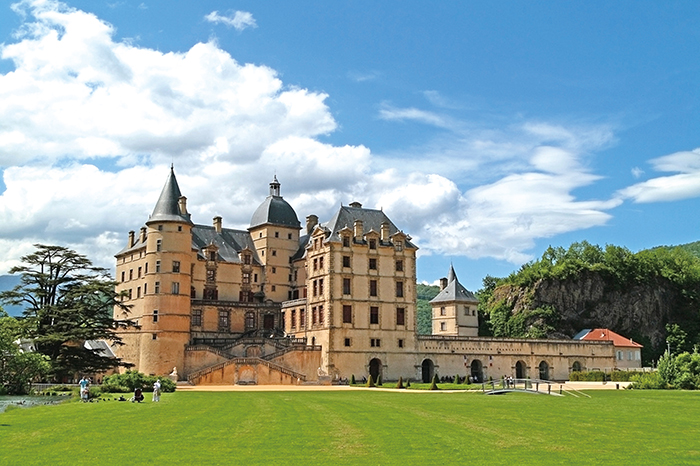Nestled at the foot of the French Alps, the French city of Grenoble immediately makes a strong visual statement to any visitor. During summer, the towering mountains that surround it are lush with verdant green forests, while winter sees them transform into snow-capped peaks, but whatever season you visit, it boasts one of the most beautiful natural vistas anywhere in Europe.
Boasting a population of just 160,000 inhabitants, the city was first settled over two millennia ago in 43BC by a Gallic tribe. First known as Cularo, it was conquered by the Romans some three centuries later, and passed through the hands of the Kingdom of Burgundy and the Holy Roman Empire before coming under the sway of the Counts of Albon in the 11th century. These rulers later adopted the title of ‘Dauphin’, and when the city joined the French empire in 1349, it was upon the condition that heirs to the French crown would henceforth use that selfsame title.
Today, in addition to being an important centre for academia and mountain sports – no doubt aided by its proximity to the French Alps – Grenoble also boasts a plethora of historic sites, countless museums and art galleries, and much more besides. Without further adieu, we delve into the top sights of this picturesque French city… La BastillePerched atop Mount Rachais, La Bastille is perhaps one of Grenoble’s most popular tourist destinations.
Its construction dates centuries back to the Middle Ages, and its strategic location has seen it experience a series of military campaigns, including the successful rebuffing during 19th century against the invading troops of the Duchy of Savoy. Boasting a system of soaring walls and Mandarin Caves, the maze-like defensive system built beneath the fort’s very foundations, it was truly a military engineering marvel of its age. Today, in addition to exploring its passageways, travellers can also visit the small but interesting on-site military museum expounding La Bastille’s history. Thanks to its elevated position, it also affords some of the most spectacular views across the city.
The cable car
One of Grenoble’s most iconic landmarks – and the speediest means of reaching La Bastille’s elevated heights – is the Cable Car. Built in 1934, it holds the distinction of being the world’s first urban cable car. Nearly as popular as the fort itself, its bubble-like carriages offer spectacular views across the surrounding landscape beyond the city, be it the wending Isère River or the tower Alpine peaks – including France’s tallest peak, Mont Blanc, on a good day – in the distance. Given the hill’s vertiginous incline, however, this is one attraction that acrophobic visitors may want to skip.
Parc Paul Mistral
Situated right in the heart of Grenoble, the Parc Paul Mistral provides a lush, verdant oasis amid the city’s bustling atmosphere. Spread across some 67 acres, locals and visitors alike can partake in a plethora of activities ranging from playing handball and street hockey to taking salsa lessons and even signing up for board game tournaments. In the midst of the tree-lined avenues, you’ll also find the Perret Tower. Unveiled in 1925, this structure dominates the park centre day and night, though the addition of twinkling lights during the twilight hours make it a particularly romantic time to visit.
Musée de Grenoble
Built in 1994, the contemporary Musée de Grenoble is a must-visit for any art aficionado. Mainly housing a collection of modern art, it includes works by such 20th-century luminaries as Andy Warhol, Matisse, Picasso, Kandinsky and Joan Miro. Elsewhere in the complex is a section dedicated to fascinating ancient artifacts from the Ancient Greek, Roman and Egyptian civilisations. An exhibition showcasing the mummified body of 6th-century Egyptian prophetess Antinoe is a particular highlight.
Musée Dauphinois
The 17th century convent that houses the Musée Dauphinois provides an aptly historic setting for its expansive collection of exhibits on the native people of the Dauphiné highlands. Hardened by the volatile Alpine weather, these highlanders soon evolved their own distinctive identity and culture, and interactive exhibitions allow visitors to track their entire history. There’s even a section dedicated to expounding the evolution of skiing from its Stone Age roots right to the Winter Olympics, which Grenoble hosted in 1968. Elsewhere within the museum’s grounds, you’ll find a historic Baroque chapel, an ancient cloister and picturesque gardens to meander through.
Grenoble’s Natural History Museum
Given that there are over 2,000 art galleries to be found in Grenoble, you may feel worn out by all its culture and art in this fabulously creative city. But fear not, for the Natural History Museum will provide a welcome interlude. In addition to hosting interactive exhibits that allow visitors to physically explore the world of Alpine wildlife, the museum also boasts a veritable treasure trove of some of the rarest flora and fauna to be found across the region. Whether discovering the underwater marine life in the on-site aquarium or strolling through the stunning 20,000sq.m Botanical Gardens, this is one destination that will appeal to people of all ages.
The Sassenage Cisterns
A short 10-minute drive beyond the bounds of Grenoble lies the commune of Sassenage, a quaint town nestled between the river and the mountains. Here, you’ll find the fascinating Sassenage Cisterns – also known as les cuves – a series of vast underground passageways that were carved by the Germe River across millions of years. Thanks to its stark landscape, walking through these caves almost feels like journeying to the centre of the earth. Expect gushing subterranean rivers, awe-inspiring geological structures and natural wonders that are completely a world away from life on the surface.











